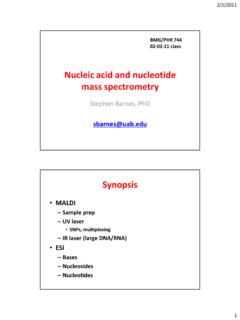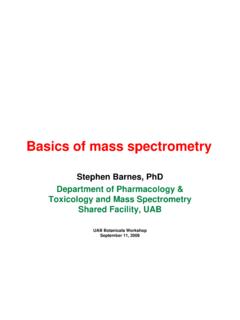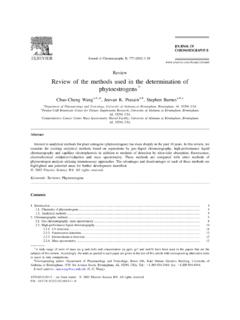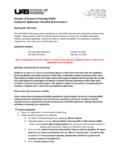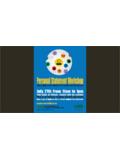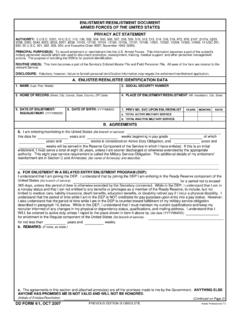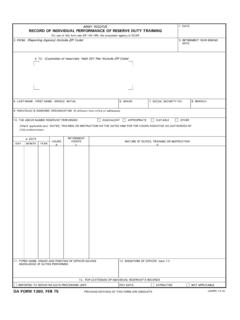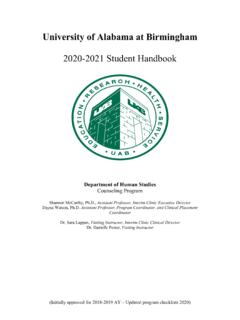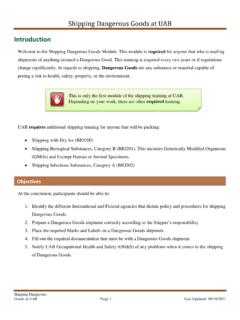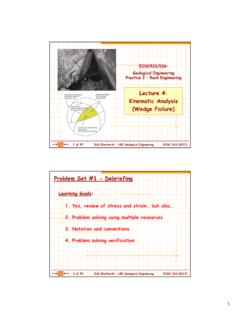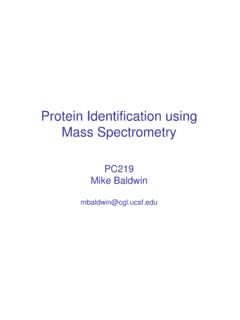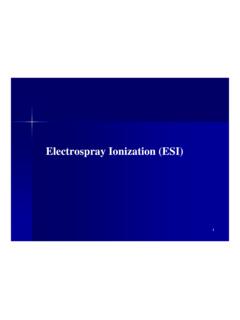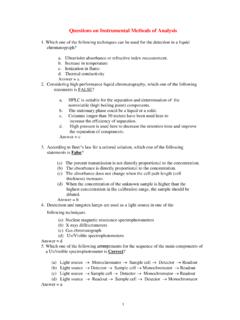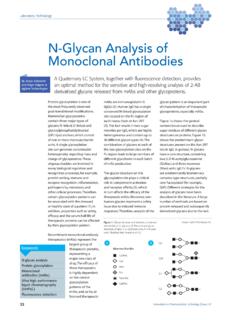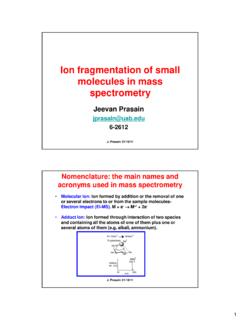Transcription of For a video that walks you through this template, and for ...
1 Instructions:The goal of this template is to help you focus your aims, one vital component of writing a successful proposal. This template is derived directly from R01 s of mine that were funded with scores better than the 5th percentile, and it has also been used by various people I ve helped, several of whom have used it to score in the top few percentile. Bottom line is, when you combine this with some of the other aspects of a great grant ( great team, great project, etc), this approach aims are a crucial part of winning over the reviewer. Your whole proposal should be written for a general science audience, not for just specialists in your field. This is particularly important in the specific aims. If you use specialized terminology without explaining it here, you will loose your reviewer s good will quickly, and your chances of funding are slim to it general, and keep it interesting.
2 Make sure to cover each of the four key components: Why, Who, What, and How (Those are explained in my book, Four Steps To F u n d i n g).And the most important thing: you must be proposing great work that your field cares about. If you re not proposing work that people care about, then great writing will not make any difference at want to thank Dr. Marshall Edgell for his initial inspiration for this template, and Dr. Peter Drain for his recent input to improve AimsIn the template below, I use examples from a proposal of mine that was funded with a very good sentences: Set the big picture, central challenge of your field that lots of people are interested in solving. For example: Post-translational modifications (PTMs) on proteins can significantly affect their function and their interactions with other proteins, so a major component of mass spectrometry (MS) based proteomic research is focused on identifying post-translational modifications present in different cellular states.
3 This should be the backdrop for the Why (for a complete explanation see Four Steps To Funding). sentences: elaborate on the problem, and what has been going on in your field to solving it. This is the introduction to the What, the theory behind what you re trying to do. But keep it interesting and for a general audience! Do not get bogged For a video that walks you through this template, and for other grant writing training, visit - Revised 2/11/12 2009-2012 Morgan C Giddings and Marketing Your Science, LLCdown in heavy factual details here, or your reviewer will become lost and uninterested. For example: PTM analysis usually proceeds by one of two methods: bottom-up is the most common, whereby all proteins are digested into peptides and then individual peptides are analyzed by tandem mass spectrometry to find mass -shifts associated with the presence of modification(s).
4 The second route is top-down analysis , where the mass of intact proteins is measured on a high accuracy MS instrument, and from the mass , protein modifications can be inferred due to a shift compared to the predicted mass in a protein database. sentences: Name a general bottleneck in your field that is slowing or stopping progress towards achieving the big picture named in the first sentence. This is a critical part of your aims! You must have a single, clear Gap that needs solving [clearing], in order to have a good proposal. This is your framing device for your Why . For example: Both methods have limitations - with bottom-up, it is difficult to find and analyze all the peptides associated with each protein, so there are usually gaps in coverage. Top-down is limited because a single mass measurement can be assigned to multiple isobaric (equal mass ) combinations of modifications, so is not definitive.
5 Sentences: elaborate on the Gap, making it more specific and focused. For example: To overcome these limitations, several groups including our own have combined top-down with bottom-up (TDBU) analyses of post-translational modifications in proteins, using top- down data to predict possible modification scenarios, and bottom-up data to determine which scenario is correct. At present, there is no openly available software for automatically combining these two different types of data sets, and analysis by hand is extremely slow and time consuming. 5.(optional) 1-2 sentences: Discuss the theory that leads up to your proposed solution, in general and non-technical terminology. Do not get bogged down in minute technical details here. (For the example I m using here, no additional theory was presented, but many successful proposals present a bit of theory at this point, often as a prelude to a hypothesis).
6 Sentences: Propose an approach to solving the roadblock. If you are working in a hypothesis-driven area of work, this is where you ll state your hypothesis. If you can tie this in with the Who your proposal will be stronger. From the Four Steps To Funding model, this is your What - your model of how the world works (within the area of your proposal). For example: We are ideally positioned to build and deliver open source software to address these limitations, having extensive experience in both top-down and bottom-up software development, as well as experience in applying TDBU data to an exhaustive analysis of E. coli ribosomal proteins. In this example, we are proposing new software, and we are For a video that walks you through this template, and for other grant writing training, visit - Revised 2/11/12 2009-2012 Morgan C Giddings and Marketing Your Science, LLCalso talking about our experience in building that software in the very same sentence.
7 If this were a hypothesis, you d do essentially the same thing, proposing your hypothesis and immediately showing why you and your team have the experience to be working on it. 7.(optional) 1-2 sentences: Explain why you and your team are the right people to implement this solution/approach. This is another critical section, it is the Who. You need to point out why not just anyone can do this work, and why you are qualified and ready to jump in and solve it. The best thing is to cite one or more previous papers of yours on the subject, or point to unpublished work, for example: Our established development track record includes PROCLAME for top-down analysis (PROtein CLeavage And Modification Engine)1 and GFS for bottom-up (Genome-based peptide Fingerprint Scanning)2-4.
8 Sentence: We are proposing to accomplish goal [or test this hypothesis] with the following specific aims: aims are your How. They need to be credible, meaning that it is realistic that you can accomplish them given your skills, your budget, and your timeframe. Each aim needs not only a how, but also a Why, as in why do this aim? What is its purpose for being? The following structure is a great way to force yourself to answer not only the How but also the Why for each aim. You may be tempted to skip this. Do so at your own peril! This formula is proven to work. Aim #: To X we will Y. - I ve used this exact format on the last 5 funded proposals for ALL of my aims. It forces you to clearly state WHY you will do the aim (X) and HOW you will do it (Y). Sometimes the HOW (Y) is divided into several sub-steps, as a numbered/lettered list, and can even be more than one sentence, if absolutely necessary.
9 For example: Aim 1: To improve the identification of post-translational modifications and amino acid substitutions on proteins by combining top-down and bottom-up mass spectrometry data, we will enhance our PROCLAME software to use a Markov chain Monte Carlo algorithm that can incorporate: a) intact - mass mass data from top-down analysis , b) peptide data from bottom-up analysis , and c) context-sensitive rules that use but are not limited by knowledge of where modifications are likely to occur. We will further enhance the program s assessment of modification frequency by ongoing analyses of protein databases like UniProt5. Here, I have underlined the Why and boldfaced the How. Again, for a good aim, it must have (optional)1-4 sentences: How clearing the hurdle fits into the big picture.
10 For the NIH, this big picture needs to be tied to improving health or curing disease. For the NSF, this may be solving one of their named grand challenges. The more For a video that walks you through this template, and for other grant writing training, visit - Revised 2/11/12 2009-2012 Morgan C Giddings and Marketing Your Science, LLCpeople afflicted and the deadlier the disease, the easier it is to establish the importance of the project in the big picture context. Now, in some proposals I ve left this off and it hasn t hurt me, such as the one we ve been using for an example. But here s an example. But here s an example from another well-scored proposal: By performing a differential analysis of proteins encoded by transcripts in a variety of tissue types, we expect to uncover knowledge about the location and timing of protein translation in cells, information about which transcripts get translated, and information about how many of the putative alternative exons predicted actually encode proteins.
